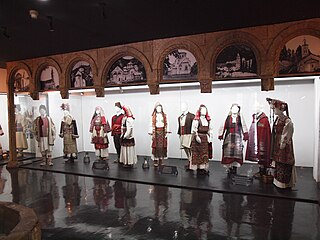
The University of Pristina is a public university located in Pristina, Kosovo. It is the institution that emerged after the disestablishment of the University of Pristina (1969–1999) as a result of the Kosovo War. The inauguration of the university was a historical occurrence not only for the people of Kosovo, but for the whole Albanian nation. On 15 February, the solemn Parliament session took place, which is also proclaimed as The University of Pristina's Day. In the composition of the newly established University of Pristina were faculties with their headquarters in Pristina: the Faculty of Philosophy, Faculty of Law and Economics, Faculty of Engineering and Faculty of Medicine. Now the University of Pristina has 17 faculties, of which 14 are academic faculties and 3 are faculties of applied sciences. Contained within the emblem is a translation of the name into Latin, Universitas Studiorum Prishtiniensis.

Football Club Prishtina, commonly known as Prishtina, is a professional football club based in Prishtina, Kosovo. The club play in the Football Superleague of Kosovo, is the most successful club in Kosovo, and is also the only Kosovar club to have never have been relegated from the league.

KF Hysi was a football club based in Podujevo, in the District of Pristina, Kosovo, that was founded in 2002.

The Fadil Vokrri Stadium, previously known as Prishtina City Stadium, is a multi-purpose stadium in Prishtina, Kosovo, which is used mostly for football matches and is the home ground of FC Prishtina and Kosovo national football team. The stadium has a capacity of 13,980.

Pristina is the capital and largest city of Kosovo. It is the administrative center of the eponymous municipality and district.
The International Festival of Young Musicians – DAM Festival Pristina is one of the most prominent cultural events taking place in the capital city of Kosovo, Pristina. Founded in 2006, DAM Festival is an annual music festival which gathers young and talented national and international musicians from all over the world. This festival works on enriching the Kosovar cultural scene with the collision of the traditional and the contemporary. DAM Fest was founded by back then art student, now well known TV producer, musician, journalist and manager of Kosovo's Philharmonic Orchestra, Dardan Selimaj.
Football in Kosovo is governed by the Football Federation of Kosovo, which was created in 1946, as a branch of the Yugoslav Football Association. Prishtina, is the club from Kosovo with most participations in the Yugoslav First League. Football is the most popular sport in Kosovo.
Christianity in Kosovo has a long-standing tradition dating to the Roman Empire. The entire Balkan region had been Christianized by the Roman, Byzantine, First Bulgarian Empire, Serbian Kingdom, Second Bulgarian Empire, and Serbian Empire till 13th century. After the Battle of Kosovo in 1389 until 1912, Kosovo was part of the Muslim Ottoman Empire, and a high level of Islamization occurred. During the time period after World War II, Kosovo was ruled by secular socialist authorities in the Socialist Federal Republic of Yugoslavia (SFRY). During that period, Kosovars became increasingly secularized. Today, 90% of Kosovo's population are from Muslim family backgrounds, most of whom are ethnic Albanians, but also including Slavic speakers and Turks.

Ramadan Ramadani (1944–2005) was a Kosovar painter from Ferizaj, Kosovo, a town southwest of Kosovo's capital city Pristina. He finished high school in his home town and in 1967 he was accepted at the Institute of Pedagogy in Prishtina, where he studied figurative arts. During his studies he was awarded the “best freestyle drawing of the year” award, one of the most prestigious awards given to students.
The literature of Kosovo is composed of literary texts written in Albanian, Serbian, Bosnian, and Turkish, specifically by authors of Kosovo. Kosovo produced several prominent writers in the Ottoman era. However, Ottoman authorities banned the written use of the Albanian language until 1912. This policy continued during Serb rule until the outbreak of World War II.

Kosovo is a partially recognized state and disputed territory located in the Balkan Peninsula in Southeastern Europe. The majority of Kosovars are ethnically Albanian. Kosovo has an expansive cultural heritage, including monuments, clothing items, museums, and traditional food.
Prishtina is the epicenter of sport in Kosovo, where activity is organized across amateur and professional levels, sport organizations and clubs, regulated by the Kosovo Olympic Committee and the Ministry of Culture, Youth and Sport. Prishtina is known for their success in Sports such as Football, Boxing, Basketball and Futsal. They compete for five seasons in the Yugoslav First League between 1983 and 1988 in which their best finish came in their first ever season in 1983-84 finishing in 8th place. In the same season they reached the Mitropa Cup finals of 1983-84, were FC Prishtina finished Runners up to Eisenstadt from Austria. as well as reaching the semifinals in the Yugoslav Cup in 1987-88.

As the capital city of Kosovo, Pristina is the heart of the cultural and artistic development of all Albanians that live in Kosovo. The department of cultural affairs is just one of the segments that arranges the cultural events, which make Pristina one of the cities with the most emphasized cultural and artistic traditions.

The National Gallery of Kosovo, formerly known as the Kosova National Art Gallery, is an art gallery situated at The University of Pristina Campus that's focused on 20th-century art.

Historical monuments in Pristina are made up of 21 monuments out of a total of 426 protected monuments all over Kosovo. A large number of these monuments date back to the Byzantine and Ottoman periods. Since 1945, the Yugoslav authorities followed the idea of constructing a modern Pristina by relying in the urban development motto “destroy the old, build the new” and this resulted with major changes in the structure of the buildings, their function and their surrounding environment. However, numerous types of monuments have been preserved, including four mosques, a restored orthodox church, an Ottoman bath, a public fountain, a clock tower, several traditional houses as well as European-influenced architecture buildings such as the Museum of Kosovo. These symbolize the historical and cultural character of Pristina as it was developed throughout centuries in the spirit of conquering empires.

Tourism in Pristina attracted 36,186 foreign visitors in 2012, which represents 74.2% of all visitors that visited Kosovo during that year. Foreign visitors mostly come from countries like Albania, Turkey, Germany, United States, Slovenia and North Macedonia, but also from other countries. Some of the most visited places in Pristina are Batllava Lake and Gadime Marble Cave, which are also among the most visited places in Kosovo.
The architecture of Kosovo dates back to the Neolithic period and includes the Copper, Bronze and Iron Ages, Antiquity and the Medieval period. It has been influenced by the presence of different civilizations and religions as evidenced by the structures which have survived to this day. Local builders have combined building techniques of conquering empires with the materials at hand and the existing conditions to develop their own varieties of dwellings.

The Imperial Mosque, also known as King's Mosque, is an Ottoman mosque located in Pristina, Kosovo. It was built in 1461 by Sultan Mehmed the Conqueror. The inscription written in Arabic alphabet in six rows which is situated in the entry portal as the exact date of construction provides the year 1461, according to the Gregorian calendar, i.e. Hijra 865 year according to Arab calendar.

Education in Kosovo is carried out in public and private institutions. Starting from 1999, education in Kosovo was subject to reforms at all levels: from preschool education up to university level. These reforms aimed at adjusting the education in Kosovo according to European and global contemporary standards. As a first step of this new system is considered the establishment of the Department of Education and Science (DES), which is followed with the creation of legal and professional infrastructure, which should facilitate the fundamental reformation of the education, and the establishment of the Ministry of Education, Science and Technology (MEST) in March 2002. During this period the private education system began to develop.

The architectural heritage of the Kosovo Albanians during Yugoslav rule was shown institutionalised disregard for decades prior to outright conflict at the end of the 20th century. Numerous Albanian cultural sites in Kosovo were destroyed during the period of Yugoslav rule and especially the Kosovo conflict (1998-1999) which constituted a war crime violating the Hague and Geneva Conventions. In all, 225 out of 600 mosques in Kosovo were damaged, vandalised, or destroyed alongside other Islamic architecture during the conflict. Additionally 500 Albanian owned kulla dwellings and three out of four well-preserved Ottoman period urban centres located in Kosovo cities were badly damaged resulting in great loss of traditional architecture. Kosovo's public libraries, of which 65 out of 183 were completely destroyed, amounted to a loss of 900,588 volumes, while Islamic libraries sustained damage or destruction resulting in the loss of rare books, manuscripts and other collections of literature. Archives belonging to the Islamic Community of Kosovo, records spanning 500 years, were also destroyed. During the war, Islamic architectural heritage posed for Yugoslav Serb paramilitary and military forces as Albanian patrimony with destruction of non-Serbian architectural heritage being a methodical and planned component of ethnic cleansing in Kosovo.


















